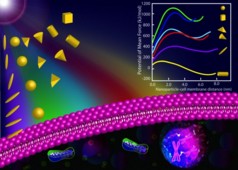Home > Press > Modifications of a nanoparticle can change chemical interactions with cell membranes
 |
Abstract:
Researchers at Syracuse University's Department of Biomedical and Chemical Engineering at L.C. Smith College of Engineering and Computer Science are studying the toxicity of commonly used nanoparticles, particles up to one million times smaller than a millimeter that could potentially penetrate and damage cell membranes.
Modifications of a nanoparticle can change chemical interactions with cell membranes
Syracuse, NY | Posted on January 25th, 2013In a recent article published along with cover art in the leading journal Langmuir entitled "Effects of nanoparticle charge and shape anisotropy on translocation through cell membranes," researchers Shikha Nangia, assistant professor of biomedical and chemical engineering (BMCE), and Radhakrishna Sureshkumar, Department Chair of BMCE and professor of physics, showed how simple shape and charge modifications of a nanoparticle can cause tremendous changes in the chemical interactions between the nanoparticle and a cell membrane.
Nanomaterials, which are currently being used as drug carriers, also pose a legitimate concern, since no universal standards exist to educate and fully protect those who handle these materials. Nanoparticles are comparable to chemicals in their potential threat because they could easily penetrate the skin or be inhaled.
"Nanotechnology has immense potential that is starting to be being realized; a comprehensive understanding of toxicity of nanoparticles will help develop better safe handling procedures in nanomanufacturing and nano-biotechnology" says Sureshkumar and Nangia, In addition, the toxicity levels of various nanoparticles can be used to our advantage in targeting cancer cells and absorbing radiation during cancer therapy. Nanotoxicity is becoming a major concern as the use of nanoparticles in imaging, therapeutics, diagnostics, catalysis, sensing and energy harvesting continues to grow dramatically.
This research project has taken place over the past year utilizing a state of the art 448 core parallel computer nicknamed "Prophet" housed in Syracuse University's Green Data Center. The research was funded by the National Science Foundation.
####
For more information, please click here
Contacts:
Ariel DuChene
315-443-2546
Copyright © Syracuse University
If you have a comment, please Contact us.Issuers of news releases, not 7th Wave, Inc. or Nanotechnology Now, are solely responsible for the accuracy of the content.
| Related Links |
| Related News Press |
News and information
![]() Simulating magnetization in a Heisenberg quantum spin chain April 5th, 2024
Simulating magnetization in a Heisenberg quantum spin chain April 5th, 2024
![]() NRL charters Navy’s quantum inertial navigation path to reduce drift April 5th, 2024
NRL charters Navy’s quantum inertial navigation path to reduce drift April 5th, 2024
![]() Discovery points path to flash-like memory for storing qubits: Rice find could hasten development of nonvolatile quantum memory April 5th, 2024
Discovery points path to flash-like memory for storing qubits: Rice find could hasten development of nonvolatile quantum memory April 5th, 2024
Govt.-Legislation/Regulation/Funding/Policy
![]() NRL charters Navy’s quantum inertial navigation path to reduce drift April 5th, 2024
NRL charters Navy’s quantum inertial navigation path to reduce drift April 5th, 2024
![]() Discovery points path to flash-like memory for storing qubits: Rice find could hasten development of nonvolatile quantum memory April 5th, 2024
Discovery points path to flash-like memory for storing qubits: Rice find could hasten development of nonvolatile quantum memory April 5th, 2024
![]() Chemical reactions can scramble quantum information as well as black holes April 5th, 2024
Chemical reactions can scramble quantum information as well as black holes April 5th, 2024
Discoveries
![]() Chemical reactions can scramble quantum information as well as black holes April 5th, 2024
Chemical reactions can scramble quantum information as well as black holes April 5th, 2024
![]() New micromaterial releases nanoparticles that selectively destroy cancer cells April 5th, 2024
New micromaterial releases nanoparticles that selectively destroy cancer cells April 5th, 2024
![]() Utilizing palladium for addressing contact issues of buried oxide thin film transistors April 5th, 2024
Utilizing palladium for addressing contact issues of buried oxide thin film transistors April 5th, 2024
Announcements
![]() NRL charters Navy’s quantum inertial navigation path to reduce drift April 5th, 2024
NRL charters Navy’s quantum inertial navigation path to reduce drift April 5th, 2024
![]() Discovery points path to flash-like memory for storing qubits: Rice find could hasten development of nonvolatile quantum memory April 5th, 2024
Discovery points path to flash-like memory for storing qubits: Rice find could hasten development of nonvolatile quantum memory April 5th, 2024
Environment
![]() Billions of nanoplastics released when microwaving baby food containers: Exposure to plastic particles kills up to 75% of cultured kidney cells July 21st, 2023
Billions of nanoplastics released when microwaving baby food containers: Exposure to plastic particles kills up to 75% of cultured kidney cells July 21st, 2023
Safety-Nanoparticles/Risk management
![]() Tests find no free-standing nanotubes released from tire tread wear September 8th, 2023
Tests find no free-standing nanotubes released from tire tread wear September 8th, 2023
![]() Billions of nanoplastics released when microwaving baby food containers: Exposure to plastic particles kills up to 75% of cultured kidney cells July 21st, 2023
Billions of nanoplastics released when microwaving baby food containers: Exposure to plastic particles kills up to 75% of cultured kidney cells July 21st, 2023
|
|
||
|
|
||
| The latest news from around the world, FREE | ||
|
|
||
|
|
||
| Premium Products | ||
|
|
||
|
Only the news you want to read!
Learn More |
||
|
|
||
|
Full-service, expert consulting
Learn More |
||
|
|
||








